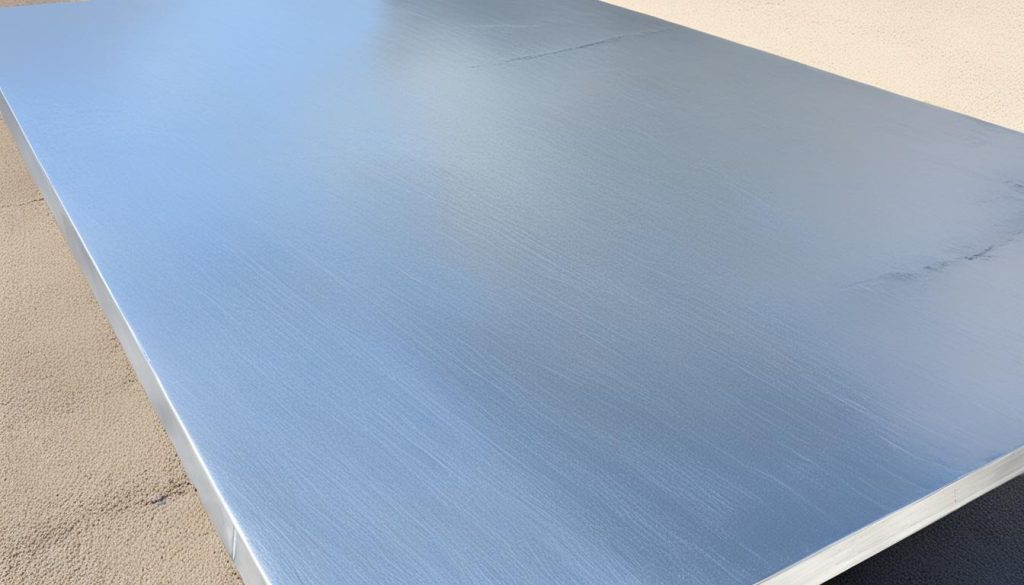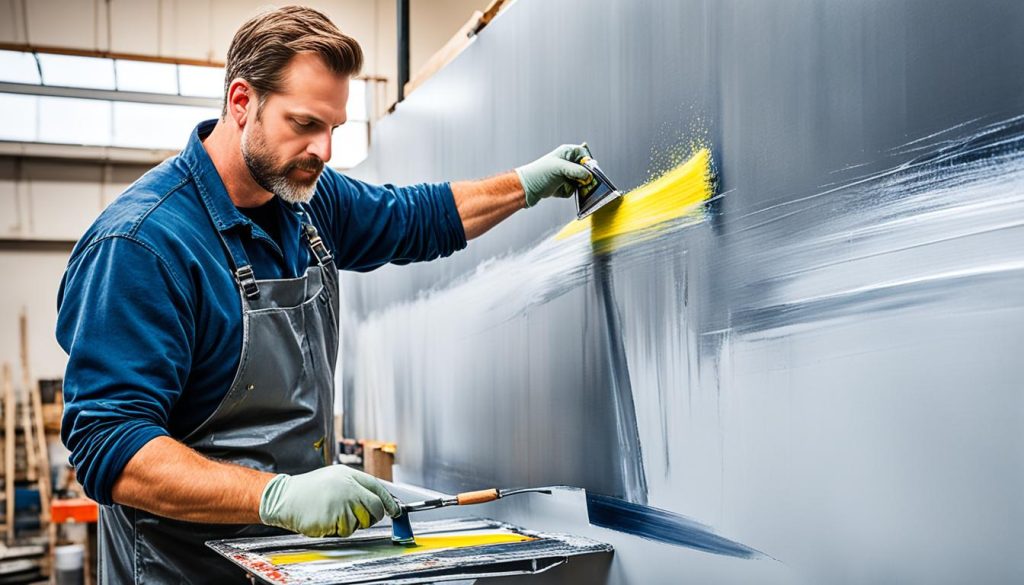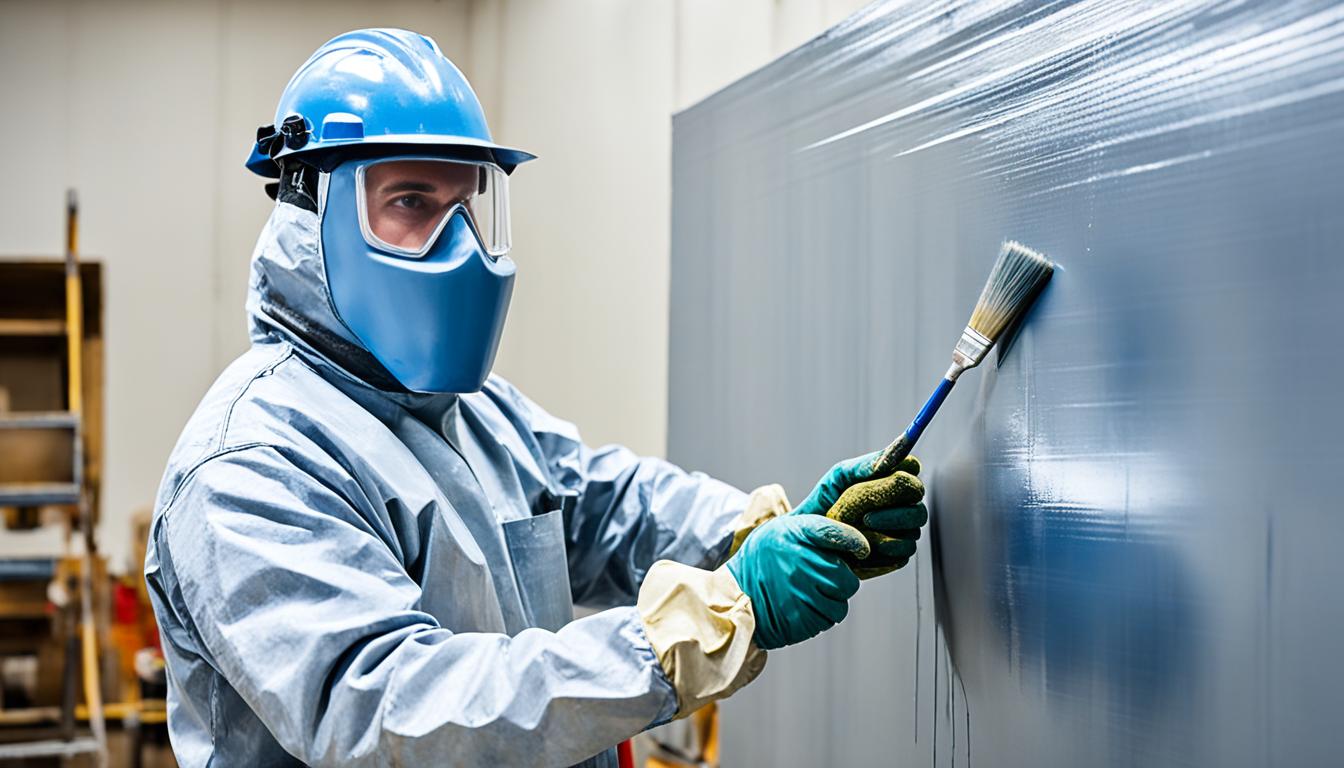When it comes to painting galvanized metal, it’s not as simple as grabbing any old paintbrush and going to town. Galvanized metal surfaces have a unique coating that can make it challenging for paint to stick effectively. If not done correctly, the paint may peel, chip, or fail to adhere at all.
In this article, I will share with you expert tips on how to safely paint galvanized metal. Whether you’re looking to spruce up an outdoor railing, update metal furniture, or add a fresh coat of paint to your galvanized roof, this guide has got you covered.
Key Takeaways:
- Properly prepare the galvanized metal surface by removing oxidation and using white vinegar to etch the coating.
- Use a primer designed specifically for metal surfaces to ensure proper adhesion and durability.
- Choose a latex-based paint formulated for exterior use to achieve a long-lasting finish.
- Apply paint in thin, even coats using a brush, roller, or paint sprayer.
- Maintain painted galvanized metal by avoiding extreme conditions and regularly cleaning the surface.
Cleaning and Prepping Galvanized Metal
Before painting galvanized metal, it’s crucial to properly clean and prepare the surface to ensure a smooth and long-lasting finish. Cleaning and prepping galvanized metal involves a few key steps:
- For weathered galvanized metal, start by using a degreaser to remove any dirt, grease, or other contaminants that may have accumulated over time. This will help create a clean surface for the paint to adhere to.
- If you’re working with new galvanized metal, white vinegar can be an effective cleaning agent. Simply dilute vinegar with water in a 1:1 ratio and use a clean cloth or sponge to wipe down the surface. This will help remove any residue or oils from the galvanized coating.
- It’s important to check weathered galvanized metal for any signs of traditional rust. If you notice any rust spots, use a wire brush or sandpaper to gently remove the rust before proceeding with the cleaning process.
Once the galvanized metal is clean and free from rust, you can proceed with the painting process. However, if the galvanized metal has not been previously painted, it’s essential to apply a primer before applying the topcoat. An even coat of ULTRA SPEC® HP Acrylic Metal Primer is recommended for optimal adhesion and durability.
| Cleaning and Prepping Galvanized Metal | Recommended Products |
|---|---|
| Degreaser for weathered galvanized metal | Brand X Degreaser |
| White vinegar for new galvanized metal | Brand Y White Vinegar |
| Wire brush or sandpaper for rust removal | Brand Z Wire Brush |
| Acrylic Metal Primer for unpainted galvanized metal | ULTRA SPEC® HP Acrylic Metal Primer |
Priming Galvanized Metal
When painting galvanized metal, it’s crucial to use a high-quality primer that is specifically designed for metal surfaces. A primer acts as a bonding agent between the metal and the paint, ensuring proper adhesion and durability of the paint job. Whether you’re painting a newly galvanized surface or one that has been previously painted, choosing the best primer is key to achieving a flawless finish.
For galvanized metal that has never been painted before, applying a coat of ULTRA SPEC® HP Acrylic Metal Primer is highly recommended. This primer is specifically formulated to adhere to the galvanized coating, providing a strong foundation for the topcoat. Its advanced acrylic formula offers excellent corrosion resistance, ensuring long-lasting protection for your metal surfaces.
If the galvanized metal has been previously painted and the existing paint is in good condition, there is no need to prime the surface again. However, it’s important to thoroughly clean and prepare the surface before applying a new coat of paint. Removing any loose or peeling paint and lightly sanding the surface will help ensure proper adhesion.
When it comes to primers for galvanized metal, it’s essential to choose a product that offers excellent adhesion, corrosion resistance, and compatibility with your chosen topcoat. Consulting with a paint professional or reading product reviews can help you make an informed decision.
Choosing the Right Paint for Galvanized Metal
When it comes to painting galvanized metal, selecting the right paint is crucial for achieving a durable and long-lasting finish. Using a paint that is specifically formulated for galvanized surfaces ensures proper adhesion and protection against the elements. Avoid using alkyd-based or oil-based paints, as they may not adhere properly to the galvanized coating. Instead, opt for a latex-based paint that is designed for exterior use.
Latex-based paints provide excellent coverage, flexibility, and resistance to cracking or peeling, making them an ideal choice for galvanized metal. Look for a paint that is specifically labeled for use on galvanized surfaces to ensure compatibility. These paints are formulated with the necessary additives to adhere effectively to the galvanized surface and provide a seamless finish.
When shopping for the best paint for galvanized metal, consider your project requirements and desired finish. Some top-quality options include:
- Brand A Galvanized Metal Paint: This paint is specially formulated to bond with galvanized surfaces, offering superior adhesion and durability. It provides a smooth and even finish, resistant to chipping and fading.
- Brand B Galvanized Metal Coating: With its advanced formula, this paint forms a protective barrier on the galvanized metal, preventing degradation from exposure to harsh weather conditions. It offers excellent color retention and long-term protection.
- Brand C Galvanized Metal Finish: Designed specifically for galvanized surfaces, this paint delivers excellent adhesion and corrosion resistance. Its high-performance formulation ensures a long-lasting, glossy finish that enhances the appearance of the metal.
Before applying the selected paint, make sure to properly clean and prep the galvanized surface according to the guidelines in the previous sections. Following these steps will help ensure the paint adheres properly and provides the desired aesthetic and protective qualities.

Remember, selecting the right paint for galvanized metal is essential for achieving a professional and durable result. Choosing a paint that is specifically formulated for this type of surface, like the options mentioned above, will provide optimal adhesion, corrosion resistance, and longevity. So, whether you’re painting outdoor furniture, a metal roof, or any other galvanized metal project, invest in high-quality paint for a finish that will stand the test of time.
Applying Paint to Galvanized Metal
When it comes to painting galvanized metal, using the right techniques can make all the difference in achieving a professional and long-lasting finish. Whether you’re working on a small DIY project or a larger-scale industrial application, here are some valuable tips to help you paint galvanized metal with ease and precision.
Choosing the Right Application Method
Before you begin painting, consider the size and complexity of the surface. Depending on your project, you can use a paintbrush, roller, or paint sprayer to apply the paint. Each method has its advantages, so choose the one that best suits your needs.
- A paintbrush is ideal for smaller areas or intricate details, allowing for greater control and precision.
- A roller can cover larger surfaces quickly and efficiently, providing even coverage.
- A paint sprayer is a great option for large-scale projects, offering fast and uniform application. However, it requires proper equipment and safety precautions.
Consider the characteristics of the surface and the type of paint you’re using when selecting the application method. Some paints may require a specific application technique, so be sure to read the manufacturer’s instructions.
Applying Thin, Even Coats
When painting galvanized metal, it’s essential to apply the paint in thin, even coats. This ensures proper coverage and helps prevent drips and runs. Start with a light layer and gradually build up the paint, allowing each coat to dry completely before applying the next. Multiple thin coats will provide better adhesion and a smoother finish compared to one heavy coat.
Make sure to cover all areas of the surface, including corners, edges, and hard-to-reach spots. Pay attention to any recessed areas that may require additional care and precision. Applying the paint evenly will result in a more professional and uniform look.
Follow Drying and Cure Times
One of the most crucial aspects of painting galvanized metal is following the drying and cure times specified by the paint manufacturer. These times can vary depending on the type of paint and environmental conditions, so refer to the paint can or technical data sheet for accurate information.
Allowing the paint to dry completely between coats and before handling the painted surface is essential for achieving optimal adhesion and durability. Rushing the process may lead to poor results, such as paint peeling or not fully adhering to the galvanized metal.

| Benefits of Applying Paint to Galvanized Metal | Effective Painting Techniques |
|---|---|
| Protects against rust and corrosion | Applying thin, even coats |
| Enhances the appearance of the metal | Using a paintbrush, roller, or sprayer |
| Increases the lifespan of the metal | Properly covering all areas |
| Allows for customization and personalization | Following drying and cure times |
Following these tips will help you achieve professional-looking results when painting galvanized metal. Remember to thoroughly prepare the surface, choose the right paint and application method, and follow the proper drying and cure times. By taking these steps, you’ll ensure a beautiful and long-lasting finish that will protect and enhance your galvanized metal objects or surfaces.
Finishing and Caring for Painted Galvanized Metal
Once the final coat of paint has dried and cured, you can install or utilize the painted galvanized metal. However, it is crucial to avoid exposing it to excessive stress and wear during the curing process, as the paint may still be vulnerable to damage.
To maintain the beauty and longevity of the painted surface, it is recommended to follow a few simple steps. First and foremost, avoid subjecting the painted galvanized metal to extreme conditions such as prolonged exposure to direct sunlight, harsh weather, or abrasive chemicals. These factors can deteriorate the paint and compromise its protective qualities.
To keep the painted surface clean and free from dirt, dust, and other contaminants, regularly wipe it down with a damp cloth. This simple maintenance routine helps preserve the appearance and integrity of the paint job.
For an extra layer of protection, consider applying a protective coating specifically designed for galvanized metal. These coatings provide an additional barrier against corrosion, UV rays, and general wear and tear. By applying a protective coating, you can extend the lifespan of the paint job and maintain its vibrant appeal for years to come.
